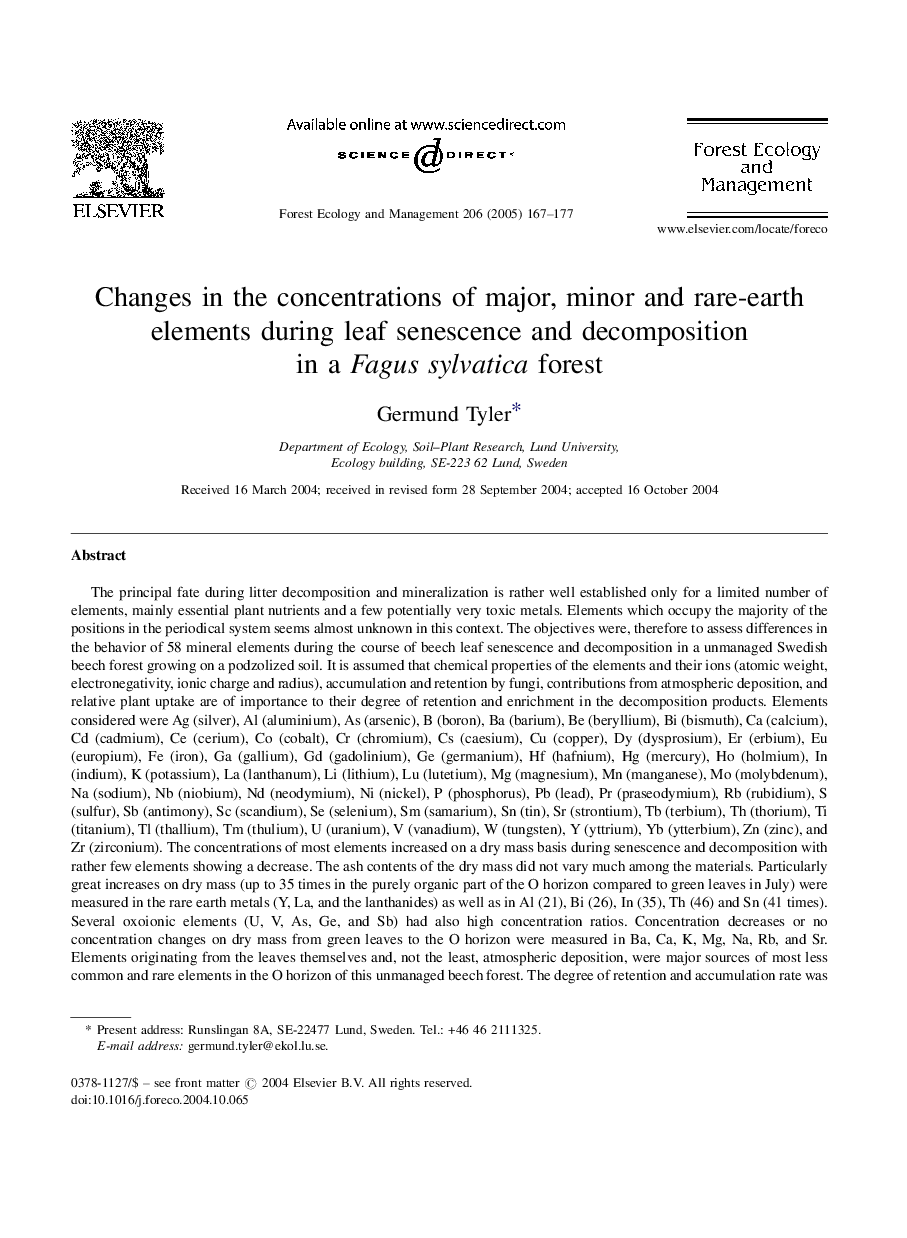| کد مقاله | کد نشریه | سال انتشار | مقاله انگلیسی | نسخه تمام متن |
|---|---|---|---|---|
| 9620469 | 159438 | 2005 | 11 صفحه PDF | دانلود رایگان |
عنوان انگلیسی مقاله ISI
Changes in the concentrations of major, minor and rare-earth elements during leaf senescence and decomposition in a Fagus sylvatica forest
دانلود مقاله + سفارش ترجمه
دانلود مقاله ISI انگلیسی
رایگان برای ایرانیان
کلمات کلیدی
موضوعات مرتبط
علوم زیستی و بیوفناوری
علوم کشاورزی و بیولوژیک
بوم شناسی، تکامل، رفتار و سامانه شناسی
پیش نمایش صفحه اول مقاله

چکیده انگلیسی
The principal fate during litter decomposition and mineralization is rather well established only for a limited number of elements, mainly essential plant nutrients and a few potentially very toxic metals. Elements which occupy the majority of the positions in the periodical system seems almost unknown in this context. The objectives were, therefore to assess differences in the behavior of 58 mineral elements during the course of beech leaf senescence and decomposition in a unmanaged Swedish beech forest growing on a podzolized soil. It is assumed that chemical properties of the elements and their ions (atomic weight, electronegativity, ionic charge and radius), accumulation and retention by fungi, contributions from atmospheric deposition, and relative plant uptake are of importance to their degree of retention and enrichment in the decomposition products. Elements considered were Ag (silver), Al (aluminium), As (arsenic), B (boron), Ba (barium), Be (beryllium), Bi (bismuth), Ca (calcium), Cd (cadmium), Ce (cerium), Co (cobalt), Cr (chromium), Cs (caesium), Cu (copper), Dy (dysprosium), Er (erbium), Eu (europium), Fe (iron), Ga (gallium), Gd (gadolinium), Ge (germanium), Hf (hafnium), Hg (mercury), Ho (holmium), In (indium), K (potassium), La (lanthanum), Li (lithium), Lu (lutetium), Mg (magnesium), Mn (manganese), Mo (molybdenum), Na (sodium), Nb (niobium), Nd (neodymium), Ni (nickel), P (phosphorus), Pb (lead), Pr (praseodymium), Rb (rubidium), S (sulfur), Sb (antimony), Sc (scandium), Se (selenium), Sm (samarium), Sn (tin), Sr (strontium), Tb (terbium), Th (thorium), Ti (titanium), Tl (thallium), Tm (thulium), U (uranium), V (vanadium), W (tungsten), Y (yttrium), Yb (ytterbium), Zn (zinc), and Zr (zirconium). The concentrations of most elements increased on a dry mass basis during senescence and decomposition with rather few elements showing a decrease. The ash contents of the dry mass did not vary much among the materials. Particularly great increases on dry mass (up to 35 times in the purely organic part of the O horizon compared to green leaves in July) were measured in the rare earth metals (Y, La, and the lanthanides) as well as in Al (21), Bi (26), In (35), Th (46) and Sn (41 times). Several oxoionic elements (U, V, As, Ge, and Sb) had also high concentration ratios. Concentration decreases or no concentration changes on dry mass from green leaves to the O horizon were measured in Ba, Ca, K, Mg, Na, Rb, and Sr. Elements originating from the leaves themselves and, not the least, atmospheric deposition, were major sources of most less common and rare elements in the O horizon of this unmanaged beech forest. The degree of retention and accumulation rate was partly controlled by chemical properties of the ions, principally atomic weight, but electronegativity was also of some positive importance to the retention. Transfer by fungi to the O horizon could be of some importance to a few, but not to most of the elements studied.
ناشر
Database: Elsevier - ScienceDirect (ساینس دایرکت)
Journal: Forest Ecology and Management - Volume 206, Issues 1â3, 15 February 2005, Pages 167-177
Journal: Forest Ecology and Management - Volume 206, Issues 1â3, 15 February 2005, Pages 167-177
نویسندگان
Germund Tyler,